Satas D., Tracton A.A. (ed.). Coatings Technology Handbook
Подождите немного. Документ загружается.

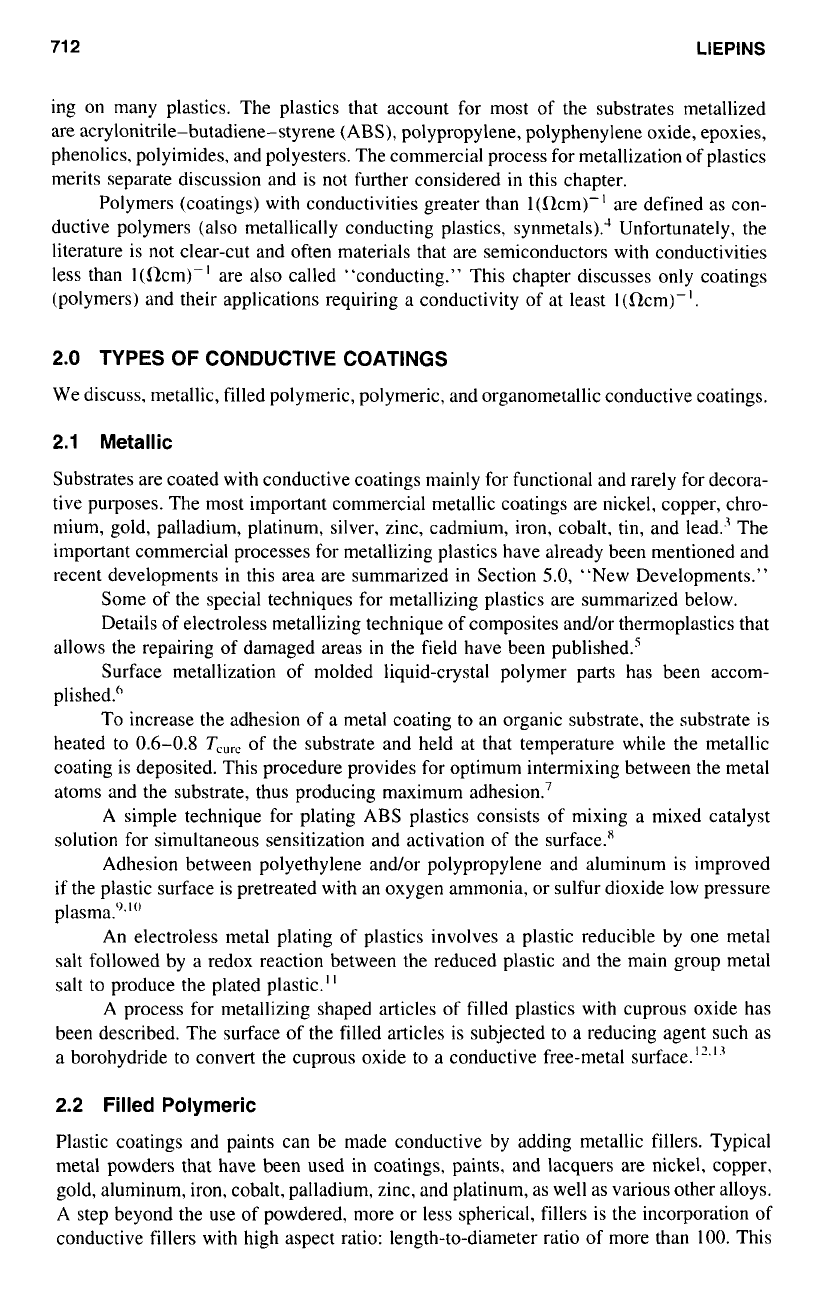
71
2
LIEPINS
ing on many plastics. The plastics that account for most
of
the substrates metallized
are acrylonitrile-butadiene-styrene (ABS), polypropylene, polyphenylene oxide, epoxies,
phenolics. polyimides, and polyesters. The commercial process for metallization of plastics
merits separate discussion and is not further considered in this chapter.
Polymers (coatings) with conductivities greater than I(ncm)" are defined
as
con-
ductive polymers
(also
metallically conducting plastics, synmetals).' Unfortunately, the
literature is not clear-cut and often materials that are semiconductors with conductivities
less than I(ikm)-' are
also
called "conducting." This chapter discusses only coatings
(polymers) and their applications requiring
a
conductivity of at least I(Rcm)".
2.0
TYPES OF CONDUCTIVE COATINGS
We discuss, metallic, filled polymeric, polymeric, and organometallic conductive coatings.
2.1
Metallic
Substrates are coated with conductive coatings mainly for functional and rarely for decora-
tive purposes. The most important commercial metallic coatings are nickel, copper, chro-
mium, gold, palladium, platinum, silver, zinc, cadmium, iron, cobalt,
tin,
and lead? The
important commercial processes for metallizing plastics have already been mentioned and
recent developments in this area are summarized in Section
5.0,
"New Developments."
Some of the special techniques for metallizing plastics are summarized below.
Details
of
electroless metallizing technique of composites and/or thermoplastics that
allows the repairing
of
damaged areas
in
the field have been published.'
Surface metallization of molded liquid-crystal polymer parts has been accom-
plished."
To increase the adhesion
of
a
metal coating
to
an organic substrate, the substrate
is
heated
to
0.6-0.8
T,,,,
of the substrate and held at that temperature while the metallic
coating is deposited. This procedure provides for optimum intermixing between the metal
atoms and the substrate, thus producing maximum adhesion.'
A simple technique for plating ABS plastics consists of mixing
a
mixed catalyst
solution for simultaneous sensitization and activation
of
the surface.*
Adhesion between polyethylene and/or polypropylene and aluminum is improved
if the plastic surface is pretreated with an oxygen ammonia, or sulfur dioxide low pressure
plasma."."'
An electroless metal plating of plastics involves
a
plastic reducible by one metal
salt followed by
a
redox reaction between the reduced plastic and the main group metal
salt
to
produce the plated plastic.''
A process for metallizing shaped articles of filled plastics with cuprous oxide has
been described. The surface
of
the filled articles is subjected to
a
reducing agent such
as
a
borohydride
to
convert the cuprous oxide to
a
conductive free-metal surface.".13
2.2
Filled Polymeric
Plastic coatings and paints can be made conductive by adding metallic fillers. Typical
metal powders that have been used in coatings, paints, and lacquers are nickel, copper,
gold, aluminum, iron, cobalt, palladium, zinc, and platinum,
as
well
as
various other alloys.
A
step beyond the use of powdered, more
or
less spherical, fillers is the incorporation of
conductive fillers with high aspect ratio: length-to-diameter ratio
of
more than
100.
This
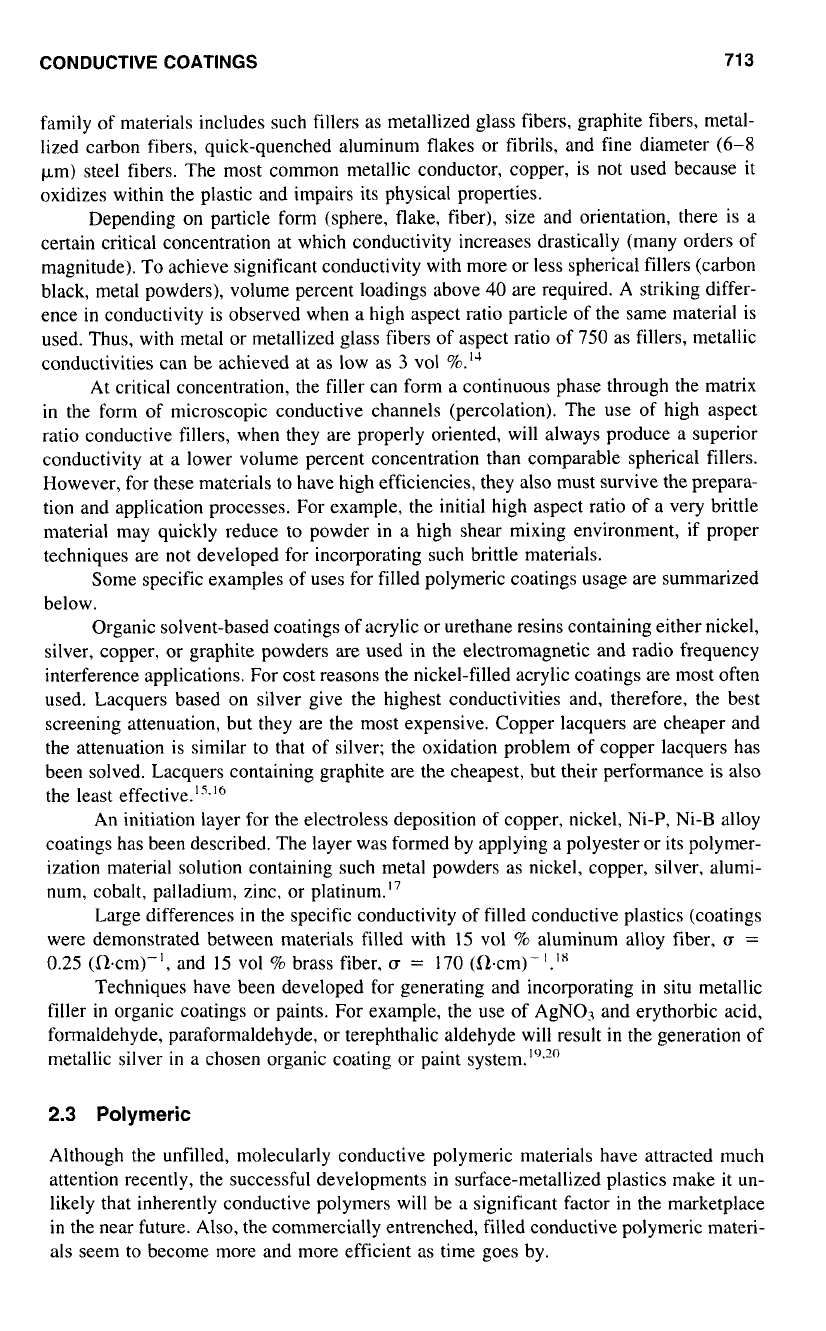
CONDUCTIVE COATINGS
71
3
family
of
materials includes such fillers as metallized glass fibers, graphite fibers, metal-
lized carbon fibers, quick-quenched aluminum flakes or fibrils, and fine diameter
(6-8
pm) steel fibers. The most common metallic conductor, copper,
is
not used because it
oxidizes within the plastic and impairs its physical properties.
Depending on particle form (sphere, flake, fiber), size and orientation, there is a
certain critical concentration at which conductivity increases drastically (many orders
of
magnitude).
To
achieve significant conductivity with more or less spherical fillers (carbon
black, metal powders), volume percent loadings above
40
are required. A striking differ-
ence in conductivity is observed when a high aspect ratio particle of the same material is
used. Thus, with metal or metallized glass fibers of aspect ratio of
750
as fillers, metallic
conductivities can be achieved at as low as
3
v01
%.l4
At critical concentration, the filler can form a continuous phase through the matrix
in
the form
of
microscopic conductive channels (percolation). The use of high aspect
ratio conductive fillers, when they are properly oriented, will always produce a superior
conductivity at a lower volume percent concentration than comparable spherical fillers.
However, for these materials to have high efficiencies, they also must survive the prepara-
tion and application processes.
For
example, the initial high aspect ratio of a very brittle
material may quickly reduce to powder in a high shear mixing environment,
if
proper
techniques are not developed for incorporating such brittle materials.
Some specific examples
of
uses for filled polymeric coatings usage are summarized
below.
Organic solvent-based coatings
of
acrylic or urethane resins containing either nickel,
silver, copper, or graphite powders are used in the electromagnetic and radio frequency
interference applications. For cost reasons the nickel-filled acrylic coatings are most often
used. Lacquers based on silver give the highest conductivities and, therefore, the best
screening attenuation, but they are the most expensive. Copper lacquers
are
cheaper and
the attenuation is similar to that of silver; the oxidation problem of copper lacquers has
been solved. Lacquers containing graphite are the cheapest, but their performance is also
the least
An initiation layer for the electroless deposition of copper, nickel, NI-P, NI-B alloy
coatings has been described. The layer was formed by applying
a
polyester or its polymer-
ization material solution containing such metal powders as nickel, copper, silver, alumi-
num, cobalt, palladium, zinc, or platinum.
Large differences in the specific conductivity of filled conductive plastics (coatings
were demonstrated between materials filled with
15
v01
%
aluminum alloy fiber,
U
=
0.25
(Rcm)-l, and
15
v01
%
brass fiber,
U
=
170
(f2.cm)".'s
Techniques have been developed
for
generating and incorporating in situ metallic
filler in organic coatings or paints. For example, the use of AgN03 and erythorbic acid,
formaldehyde, paraformaldehyde, or terephthalic aldehyde will result in the generation of
metallic silver in
a
chosen organic coating or paint
2.3
Polymeric
Although the unfilled, molecularly conductive polymeric materials have attracted much
attention recently, the successful developments in surface-metallized plastics make it un-
likely that inherently conductive polymers will be a significant factor in the marketplace
in
the near future. Also, the commercially entrenched, filled conductive polymeric materi-
als seem to become more and more efficient as time goes by.
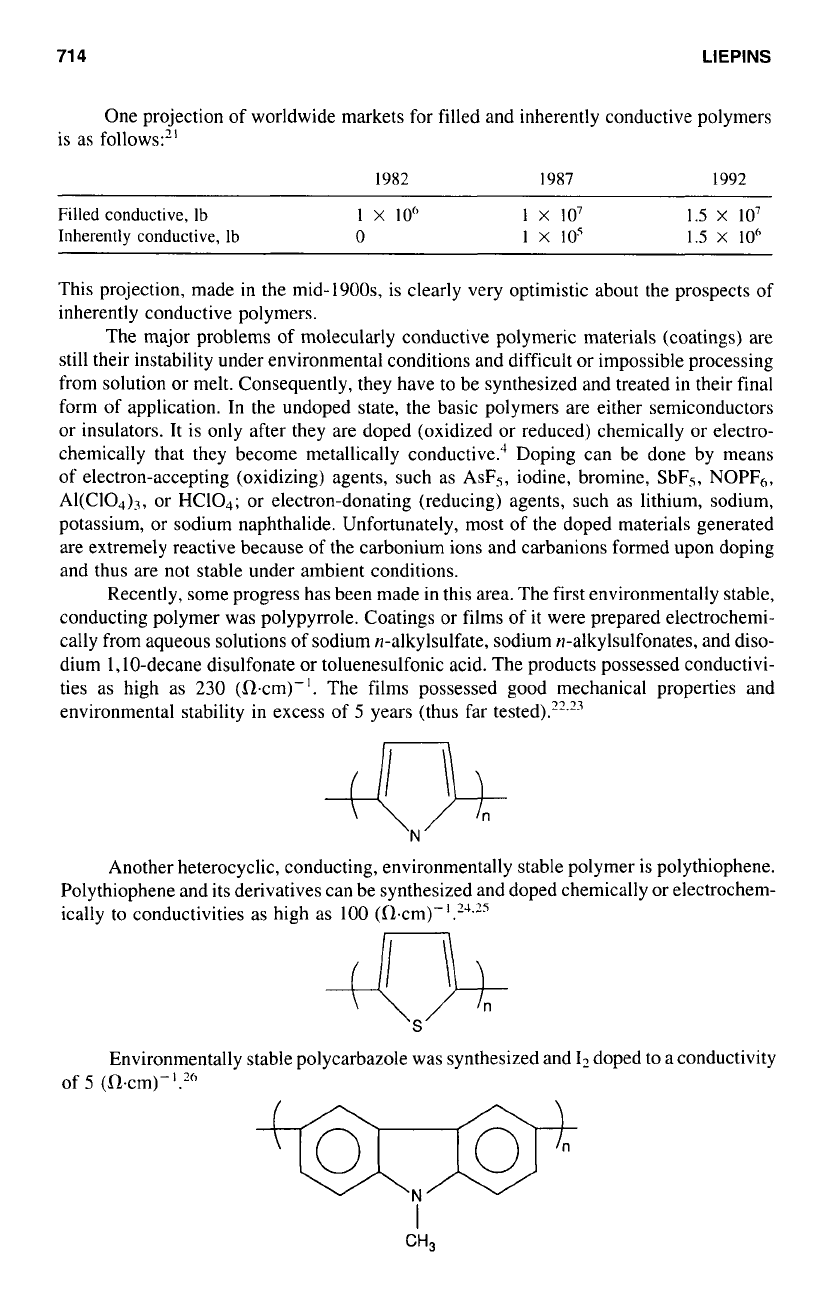
71
4
LIEPINS
One projection of worldwide markets for filled and inherently conductive polymers
is as folIows:”
1982 1987 1992
~
Filled conductive,
Ib
1
x
IO”
I
X
10’
1.5
X
10’
Inherently
conductive,
Ib
0
1
x
lo5
1.5
x
106
~~
This projection, made in the mid-l900s, is clearly very optimistic about the prospects
of
inherently conductive polymers.
The major problems of molecularly conductive polymeric materials (coatings) are
still their instability under environmental conditions and difficult or impossible processing
from solution or melt. Consequently, they have to be synthesized and treated in their final
form
of
application. In the undoped state, the basic polymers are either semiconductors
or insulators. It
is
only after they are doped (oxidized or reduced) chemically or electro-
chemically that they become metallically conductive.4 Doping can be done by means
of electron-accepting (oxidizing) agents, such
as
AsFS, iodine, bromine, SbFS, NOPFh,
AI(C104)3, or HCIO,; or electron-donating (reducing) agents, such
as
lithium, sodium,
potassium, or sodium naphthalide. Unfortunately, most of the doped materials generated
are extremely reactive because of the carbonium ions and carbanions formed upon doping
and thus are not stable under ambient conditions.
Recently, some progress has been made in this area. The first environmentally stable,
conducting polymer was polypyrrole. Coatings or films
of
it were prepared electrochemi-
cally from aqueous solutions
of
sodium n-alkylsulfate, sodium n-alkylsulfonates, and diso-
dium
I,
10-decane disulfonate or toluenesulfonic acid. The products possessed conductivi-
ties
as
high
as
230
(R.cm)-’. The films possessed good mechanical properties and
environmental stability in excess
of
5
years (thus far tested).’’.23
Another heterocyclic, conducting, environmentally stable polymer is polythiophene.
Polythiophene and its derivatives can be synthesized and doped chemically or electrochem-
ically to conductivities as high
as
100
(R~cm)-’.’J.”
Environmentally stable polycarbazole was synthesized and
I2
doped to a conductivity
of
5
(Rem)".'"
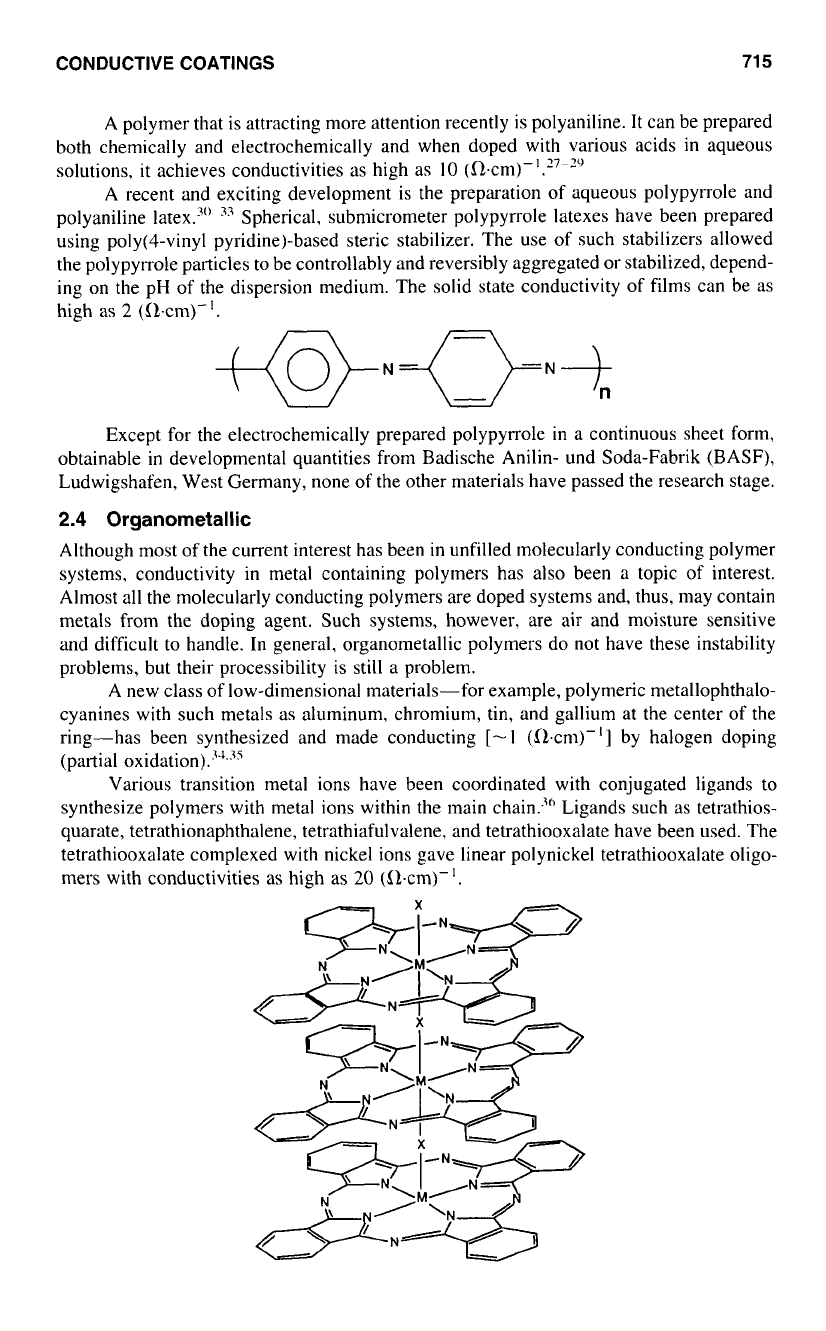
CONDUCTIVE COATINGS
71
5
A polymer that is attracting more attention recently is polyaniline. It can be prepared
both chemically and electrochemically and when doped with various acids in aqueous
solutions, it achieves conductivities as high as
10
(R.~n1)".'~""
A recent and exciting development is the preparation of aqueous polypyrrole and
polyaniline latex."' Spherical. submicrometer polypyrrole latexes have been prepared
using poly(4-vinyl pyridine)-based steric stabilizer. The use of such stabilizers allowed
the polypyrrole particles to be controllably and reversibly aggregated or stabilized, depend-
ing
on
the pH of the dispersion medium. The solid state conductivity of films can be as
high as 2 (Ckm)".
N
Except for the electrochemically prepared polypyrrole in a continuous sheet form,
obtainable
in
developmental quantities from Badische Anilin- und Soda-Fabrik (BASF),
Ludwigshafen, West Germany, none
of
the other materials have passed the research stage.
2.4
Organometallic
Although most of the current interest has been in unfilled molecularly conducting polymer
systems, conductivity in metal containing polymers has also been a topic
of
interest.
Almost all the molecularly conducting polymers are doped systems and, thus, may contain
metals from the doping agent. Such systems, however, are air and moisture sensitive
and difficult
to
handle. In general, organometallic polymers do not have these instability
problems, but their processibility is still a problem.
A
new class of low-dimensional materials-for example, polymeric metallophthalo-
cyanines with such metals as aluminum, chromium, tin, and gallium at the center of the
ring-has been synthesized and made conducting
[-l
(fhn)-'] by halogen doping
(partial oxidation).7J.35
Various transition metal ions have been coordinated with conjugated ligands to
synthesize polymers with metal ions within the main chain." Ligands such as tetrathios-
quarate, tetrathionaphthalene, tetrathiafulvalene, and tetrathiooxalate have been used. The
tetrathiooxalate complexed with nickel ions gave linear polynickel tetrathiooxalate oligo-
mers with conductivities as high as 20 (km)-'.
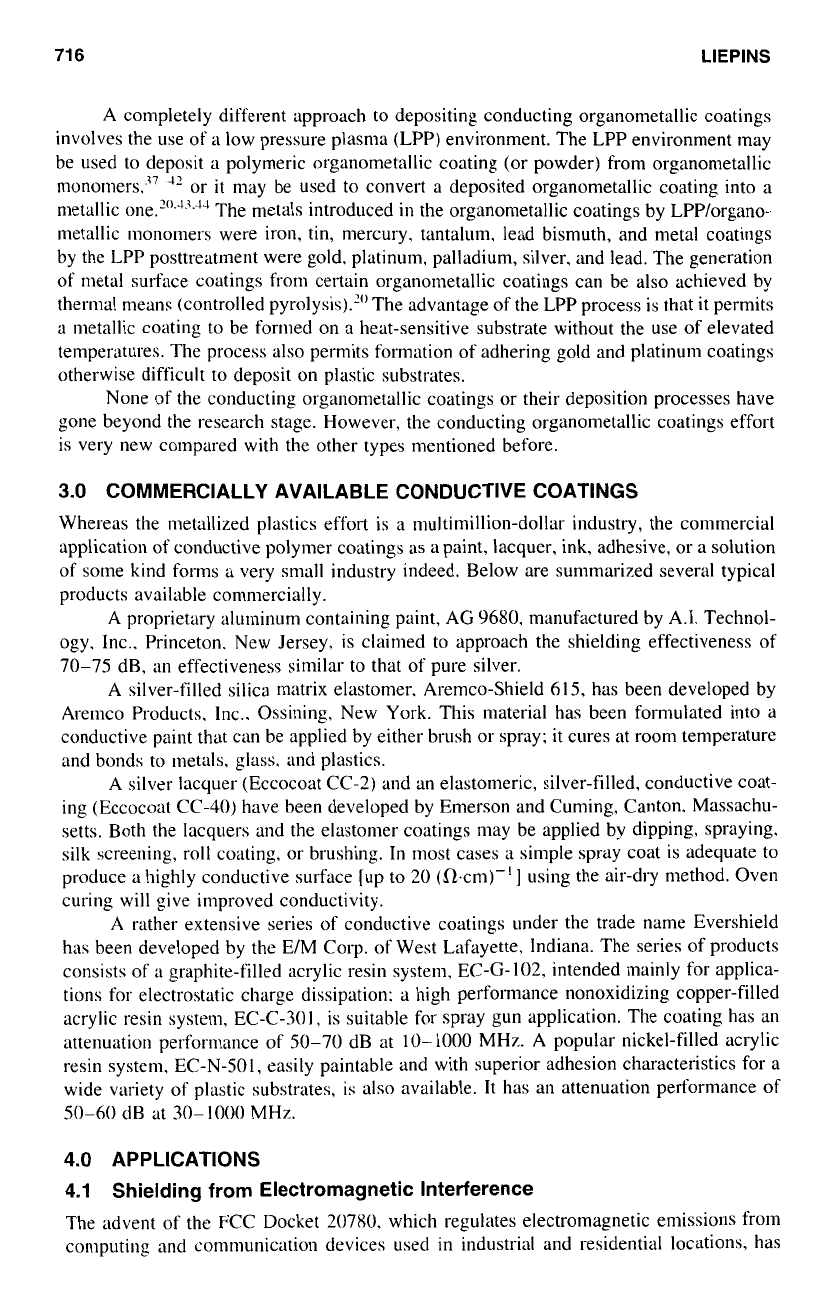
71
6
LIEPINS
A completely different approach
to
depositing conducting organometallic coatings
involves the use of
a
low pressure plasma (LPP) environment. The LPP environment may
be used to deposit a polymeric organometallic coating (or powder) from organometallic
mono~ners:~'
''
or
it
may be used
to
convert
a
deposited organometallic coating into a
metallic one."."2.'" The metals introduced
in
the organometallic coatings by LPP/organo-
metallic monomers were iron, tin, mercury. tantalum, lead bismuth, and metal coatings
by the LPP posttreatment were gold. platinum. palladium, silver. and lead. The generation
of
metal surface coatings from certain organometallic coatings can be also achieved by
thermal means (controlled pyrolysis)."' The advantage of the LPP process is that it permits
a metallic coating to be formed on
a
heat-sensitive substrate without the use
of
elevated
temperatures. The process also permits formation of adhering gold and platinum coatings
otherwise difficult
to
deposit
on
plastic substrates.
None of the conducting organometallic coatings or their deposition processes have
gone beyond the research stage. However. the conducting organometallic coatings effort
is very new compared with the other types mentioned before.
3.0
COMMERCIALLY AVAILABLE CONDUCTIVE COATINGS
Whereas the metallized plastics effort is a multimillion-dollar industry, the conlmercial
application of conductive polymer coatings
as
a paint, lacquer, ink, adhesive, or a solution
of some kind forms a very small industry indeed. Below are summarized several typical
products available commercially.
A proprietary aluminum containing paint, AG
9680.
manufactured by A.I. Technol-
ogy, Inc.. Princeton. New Jersey. is claimed to approach the shielding effectiveness
of
70-75 dB,
an
effectiveness similar to that
of
pure silver.
A silver-filled silica matrix elastomer. Aremco-Shield 615, has been developed by
Aremco Products. Inc.. Ossining, New York. This material has been formulated into a
conductive paint that can be applied by either brush or spray; it cures at room temperature
and bonds to metals. glass. and plastics.
A silver lacquer (Eccocoat CC-2) and an elastomeric, silver-filled, conductive coat-
ing (Eccocoat CC-40) have been developed by Emerson and Cuming, Canton. Massachu-
setts. Both the lacquers and the elastomer coatings may be applied by dipping, spraying.
silk screening, roll coating. or brushing. In most cases
a
simple spray coat is adequate to
produce a highly conductive surface [up
to
20 (R.cm)"] using the air-dry method. Oven
curing will give improved conductivity.
A
rather extensive series of conductive coatings under the trade name Evershield
has been developed by the
E/M
Corp.
of
West Lafayette, Indiana. The series of products
consists
of
;I
graphite-filled acrylic resin system, ECG 102, intended mainly for applica-
tions for electrostatic charge dissipation: a high performance nonoxidizing copper-filled
acrylic resin system, EC-C-301, is suitable for spray gun application. The coating has an
attenuation performance of
50-70
dB at
10-
1000 MHz. A popular nickel-filled acrylic
resin system, EC-N-501, easily paintable and with superior adhesion characteristics for
a
wide variety
of
plastic substrates, is also available. It has an attenuation performance
of
50-60
dB
at 30-1000
MHz.
4.0
APPLICATIONS
4.1
Shielding from Electromagnetic Interference
The advent of the
FCC
Docket
20780,
which regulates electromagnetic emissions from
computing and communication devices used in industrial and residential locations, has
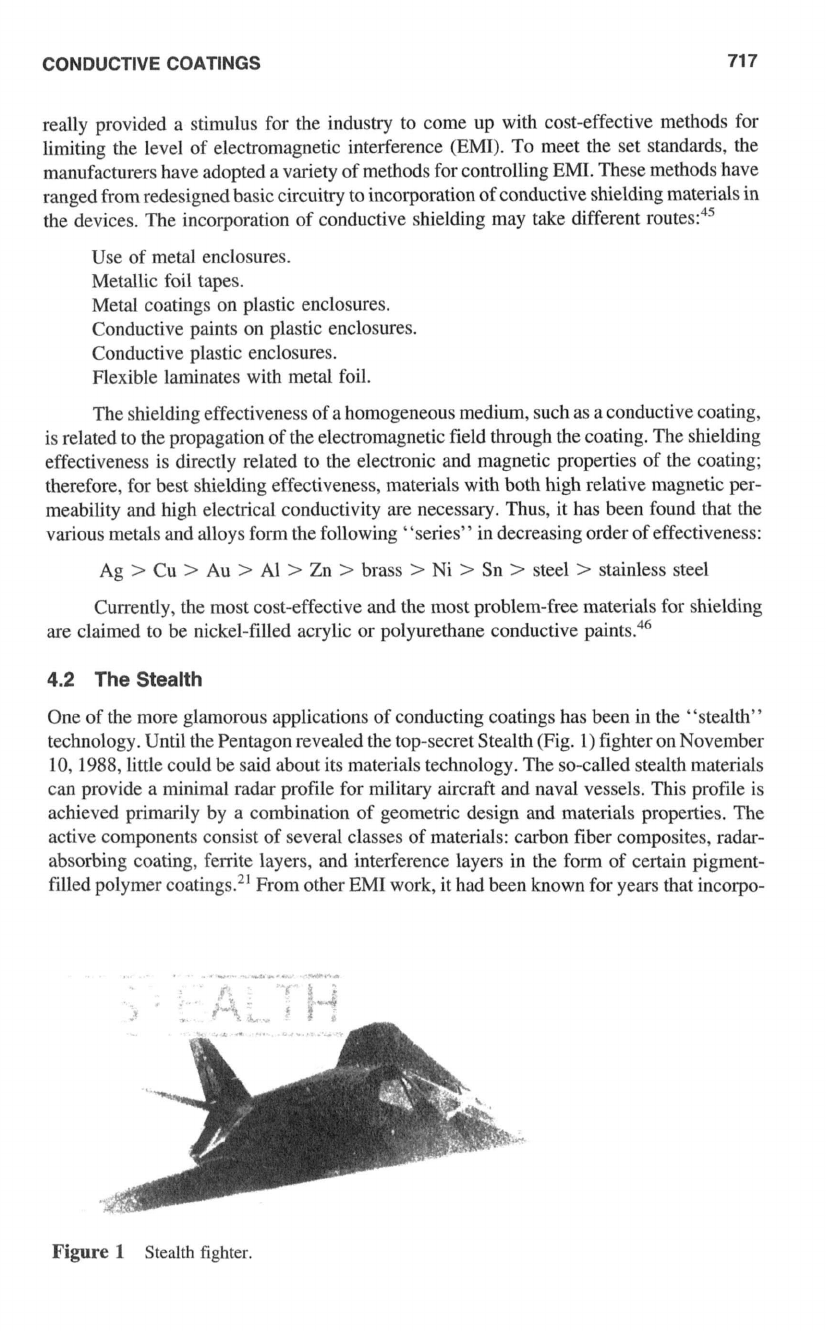
CONDUCTIVE COATINGS
71
7
really provided a stimulus for the industry to come up with cost-effective methods for
limiting the level of electromagnetic interference
(EMI).
To meet the set standards, the
manufacturers have adopted a variety of methods for controlling
EMI.
These methods have
ranged from redesigned basic circuitry to incorporation of conductive shielding materials in
the devices. The incorporation of conductive shielding may take different routes:45
Use of metal enclosures.
Metallic foil tapes.
Metal coatings
on
plastic enclosures.
Conductive paints
on
plastic enclosures.
Conductive plastic enclosures.
Flexible laminates with metal foil.
The shielding effectiveness of a homogeneous medium, such as a conductive coating,
is related to the propagation of the electromagnetic field through the coating. The shielding
effectiveness is directly related to the electronic and magnetic properties of the coating;
therefore, for best shielding effectiveness, materials with both high relative magnetic per-
meability and high electrical conductivity are necessary. Thus, it has been found that the
various metals and alloys form the following “series” in decreasing order of effectiveness:
Ag
>
Cu
>
Au
>
AI
>
Zn
>
brass
>
Ni
>
Sn
>
steel
>
stainless steel
Currently, the most cost-effective and the most problem-free materials for shielding
are claimed to be nickel-filled acrylic
or
polyurethane conductive paints!6
4.2
The Stealth
One
of
the more glamorous applications of conducting coatings has been in the “stealth”
technology. Until the Pentagon revealed the top-secret Stealth (Fig.
1)
fighter on November
10,
1988,
little could be said about its materials technology. The so-called stealth materials
can provide a minimal radar profile for military aircraft and naval vessels. This profile is
achieved primarily by a combination of geometric design and materials properties. The
active components consist of several classes of materials: carbon fiber composites, radar-
absorbing coating, femte layers, and interference layers in the form
of
certain pigment-
filled polymer coatings.*’ From other
EM1
work, it had been known for years that incorpo-
Figure
1
Stealth fighter.
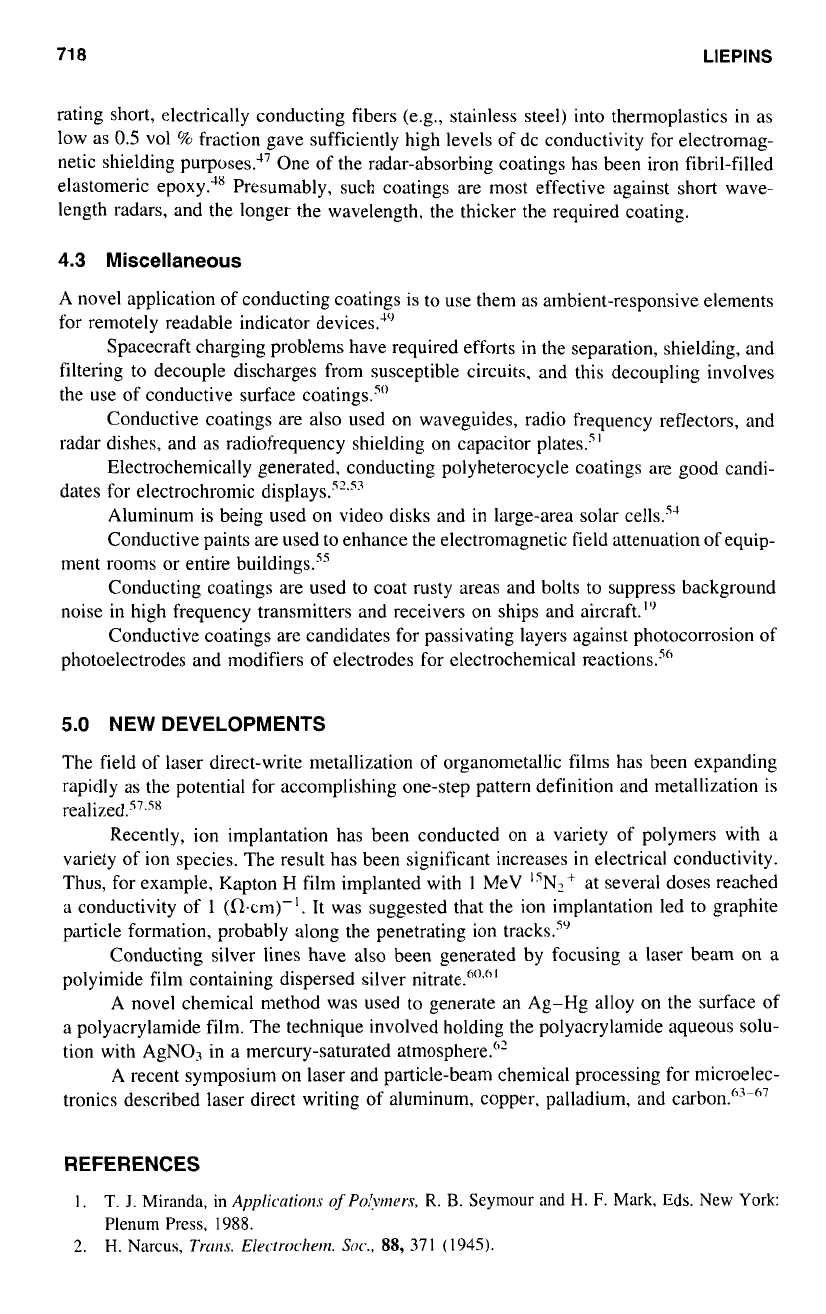
71
8
LIEPINS
rating short, electrically conducting fibers (e.g., stainless steel) into thermoplastics in as
low
as
0.5
v01
YO
fraction gave sufficiently high levels of dc conductivity for electromag-
netic shielding purposes." One of the radar-absorbing coatings has been iron fibril-filled
elastomeric epoxy.lx Presumably, such coatings are most effective against short wave-
length radars, and the longer the wavelength, the thicker the required coating.
4.3
Miscellaneous
A novel application of conducting coatings is to use them as ambient-responsive elements
for remotely readable indicator devices.J"
Spacecraft charging problems have required efforts in the separation, shielding, and
filtering to decouple discharges from susceptible circuits, and this decoupling involves
the use of conductive surface coatings.50
Conductive coatings are
also
used on waveguides, radio frequency reflectors, and
radar dishes, and as radiofrequency shielding on capacitor plates."
Electrochemically generated, conducting polyheterocycle coatings are good candi-
dates for electrochromic displays.5'.5'
Aluminum is being used on video disks and in large-area solar cells.''
Conductive paints are used to enhance the electromagnetic field attenuation of equip-
Conducting coatings are used to coat rusty areas and bolts to suppress background
Conductive coatings are candidates for passivating layers against photocorrosion
of
ment rooms or entire buildings."
noise in high frequency transmitters and receivers on ships and aircraft."'
photoelectrodes and modifiers of electrodes for electrochemical reactions.s6
5.0 NEW DEVELOPMENTS
The field of laser direct-write metallization of organometallic films has been expanding
rapidly as the potential for accomplishing one-step pattern definition and metallization is
realized."~58
Recently, ion implantation has been conducted
on
a variety of polymers with a
variety of ion species. The result has been significant increases
in
electrical conductivity.
Thus, for example, Kapton H film implanted with
1
MeV
"N1+
at several doses reached
a
conductivity of
1
(fl.cm)-l. It was suggested that the ion implantation led to graphite
particle formation, probably along the penetrating ion tracks."'
Conducting silver lines have also been generated by focusing a laser beam on a
polyimide film containing dispersed silver nitrate.""."'
A novel chemical method was used
to
generate an Ag-Hg alloy on the surface
of
a
polyacrylamide film. The technique involved holding the polyacrylamide aqueous solu-
tion with AgN03 in a mercury-saturated atmosphere."'
A recent symposium on laser and particle-beam chemical processing for microelec-
tronics described laser direct writing of aluminum, copper, palladium, and
REFERENCES
I.
T.
J.
Miranda, in
Appplicrtfiorzs
ofPo!\nwrs,
R.
B.
Seymour and
H.
F.
Mark,
Eds.
New
York:
2.
H.
Narcus,
Trcms.
Elec~rochern.
Soc.,
88,
371
(1945).
Plenum Press.
1988.
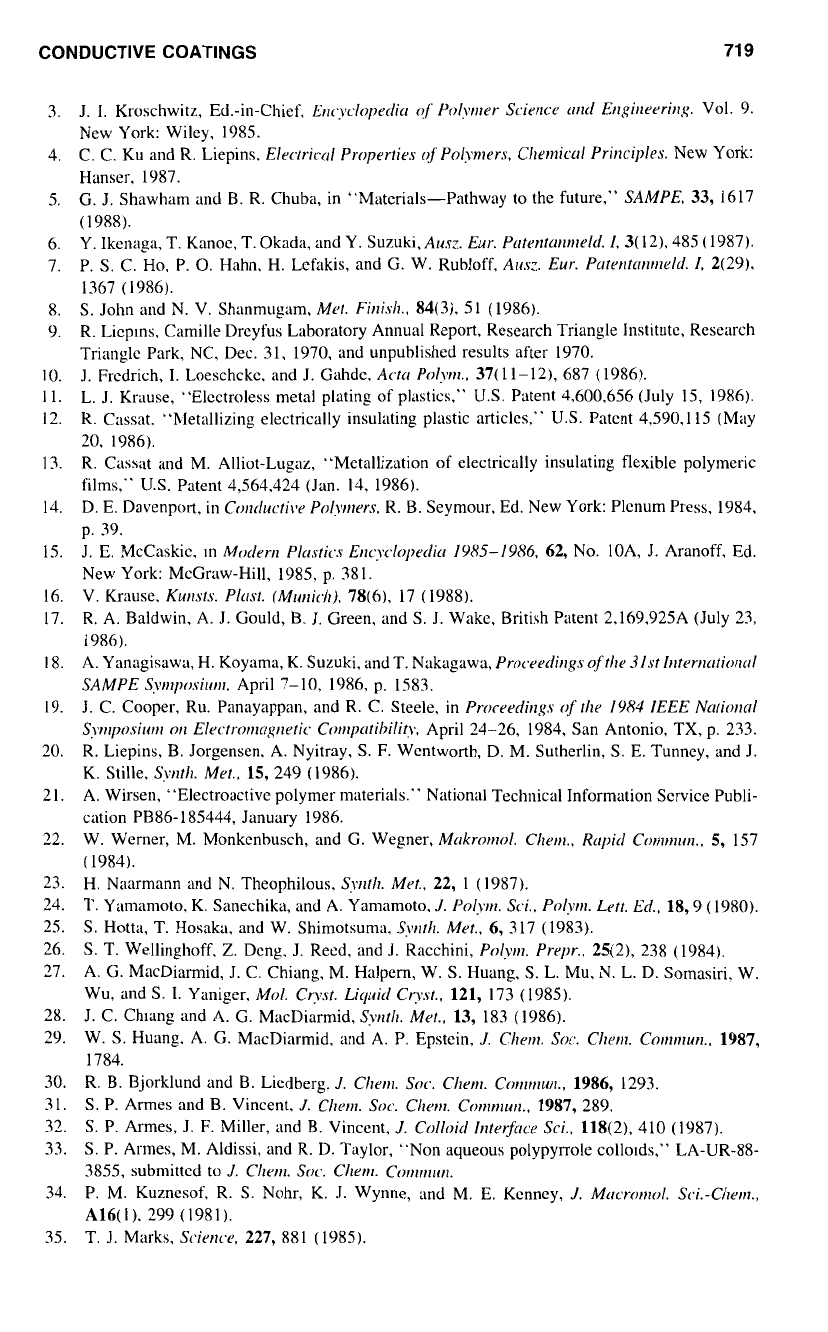
CONDUCTIVE
COATINGS
71
9
3.
4.
S.
6.
7.
8.
9.
10.
11.
12.
13.
14.
15.
16.
17.
18.
19.
20.
21.
22.
23.
24.
25.
26.
27.
28
29
30.
31.
32.
33.
34.
J.
I.
Kroschwitz, Ed.-in-Chief,
Errc:\'c/opedicc
of'
Polytrrer
Scirr~ce
.hgirlrrrirrg.
vol.
9.
New York: Wiley. 1985.
C.
C.
Ku
and R. Liepins,
Electriccrl Properties
of
Polymers.
Chemicd
Principles.
New York:
Hansel-, 1987.
G.
J.
Shawham and B. R. Chuba, in "Materials-Pathway to the future,"
SAMPE,
33,
1617
(I
988).
Y. Ikenaga, T. Kanoe, T. Okada, and Y. Suzuki,
Ausz.
Eur.
Pntentarfrrreld.
1.
3(
12), 485 (1987).
P.
S.
C.
Ho. P.
0.
Hahn, H. Lefakis, and
G.
W. Rubloff,
Aux.
Eur.
Paterltcrrrnleld.
I.
2(29).
1367 (1986).
S.
John and
N.
V. Shanmugam,
Me/.
Firrish.,
84(3),
51
(1986).
R. Licptns, Camille Drcyfus Laboratory Annual Report, Research Triangle Institute, Research
Trinngle Park, NC, Dec.
31.
1970. and unpublished results after 1970.
J. Fredrich,
I.
Loeschckc. and J. Gahde.
Actcc
Polyrrr.,
37(1l-l2), 687 (1986).
L.
J.
Krnuse, "Electroless metal plating of plastics," U.S. Patent 4,600.656 (July 15, 1986).
R. Cassat. "Metallizing electrically insulating plastic articles,"
U.S.
Patent 4,590,1 15 (May
20,
1986).
R. Cnssat and M. Aht-Lugaz, "Metallization of electrically insulating flexible polymeric
films,"
U.S.
Patent 4,564.424 (Jan.
14,
1986).
D. E. Davenport, in
COrld/4c/iw
Po/wrers.
R. B. Seymour, Ed. New York: Plenum Press, 1984.
J.
E.
McCaskic.
tn
Modert~
PItrstics
Etlcyclopeditr
IY85-1Y86,
62, No. 10A,
J.
Aranoff. Ed.
New York: McGraw-Hill, 1985,
p.
381.
V.
Krause,
Kurrsts.
Pltrsr.
(Murrich).
78(6), 17 (1988).
R.
A.
Baldwin,
A.
J. Could, B. J. Green, and
S.
J.
Wake, British Patent 2.169.925A (July 23,
1986).
A.
Yanagisawa, H. Koyama, K. Suzuki, and T. Nakagawa,
Proc~edir~g.~
ofthe
31st
Intrnrtrtiorltrl
SAMPE
Swrposiutrr.
April 7-10, 1986,
p.
1583.
J.
C. Cooper, Ru. Panayappan, and R. C. Steele,
in
Proceedings
ofthe
1984
IEEE Ncrtinr~crl
S~W/JO.S~U~?I
011
E/ectrormgnetic
Comp"tihi/ity.
April 24-26, 1984, San Antonio, TX,
p.
233.
R. Liepins, B. Jorgensen. A. Nyitray.
S.
F. Wcntworth, D. M. Sutherlin,
S.
E.
Tunney, and J.
K.
Stille,
Syrltlr.
Met.,
15,
249 (1986).
A.
Wirsen, "Electroactivc polymer materials." National Technical Information Service Publi-
cation PB86-185444, January 1986.
W. Werner, M. Monkenbusch, and G. Wegner,
Merkrorrrol.
Chetn.,
Rtrpid
Conr~~r~~~r.,
5,
157
(1984).
H. Naarmann and N. Theophilous.
Syrlth.
Met..
22,
1
(1987).
T. Ynmamoto. K. Sanechika, and
A.
Yamamoto.
J.
Polyrn.
Sci..
Po/w1.
Lett.
Ed.,
18,
9 (1980).
S.
Hotta, T. Hosnka, and W. Shimotsuma,
Syth. Met..
6,
317 (1983).
S.
T. Wellinghoff.
Z.
Dcng. J. Reed, and J. Racchini,
Polyru.
Prepr.,
25(2), 238 (1984).
A.
G. MacDiarmid,
J.
C. Chiang. M. Halpern, W.
S.
Huang,
S.
L. Mu. N. L. D. Somasiri, W.
Wu, and
S.
1.
Yaniger.
Mol.
Cryst.
Liquid
C~.st..
121, 173 (1985).
J.
C. Chtang and
A.
G. MacDiarmid,
Syr~th.
Mer.,
13,
183 (1986).
W.
S.
Huang.
A.
G.
MacDiarmid, and
A.
P. Epstein,
J.
Chern.
Soc.
Clrern.
Cortlmun.,
1987,
1784.
R. B. Bjorklund and B. Liedberg,
J.
C/renl.
Soc.
Chenr.
Con~n~url.,
1986, 1293.
S.
P. Armes and
B.
Vincent.
J.
Chcwl.
Soc.
Chrrrl.
Comnlur~.,
1987, 289.
S.
P. Armes, J.
F.
Miller, and B. Vincent,
J.
Cdloid
Interjcrce
Sci.,
118(2),
410
(1987).
S.
P. Armes, M. Aldissi, and R. D. Taylor, "Non aqueous polypyrrole collotds," LA-UR-88-
3855, submitted
to
J.
Clrer~.
Soc.
Cherrr.
Conrmun.
P. M. Kuznesof. R.
S.
Nohr, K. J. Wynne, and M.
E.
Kenney,
J.
Mrrcrotnol.
Sci.-C/wrtl.,
A16(
I).
299 (1981
).
p.
39.
35. T.
J.
Marks.
Science.
227,
881
(1985).
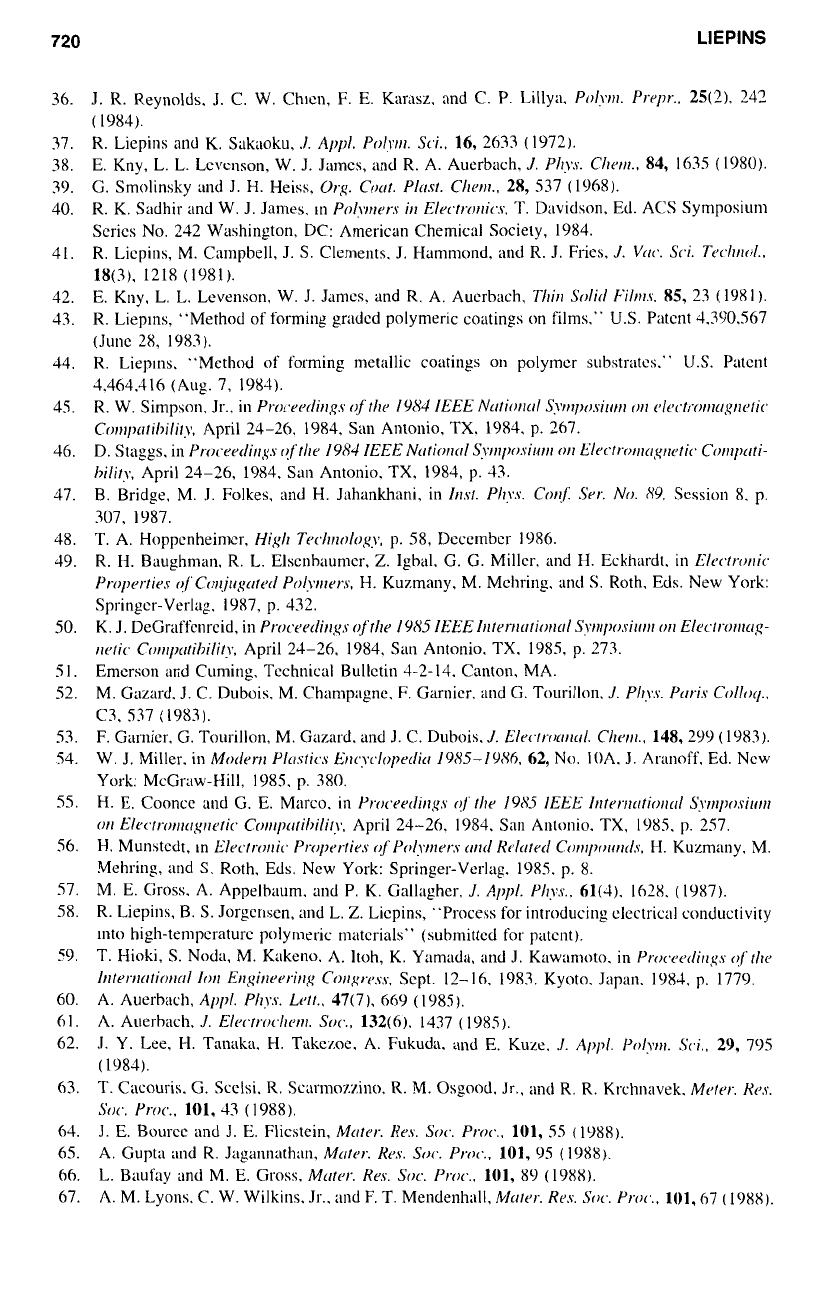
720
LIEPINS
36.
J.
R. Reynolds. J. C. W. Chlen, F.
E.
Karasz.
and
C.
P.
Lillya.
Polyrr~.
Prrpr.,
25(2).
242
37. R. Liepins
and
K.
Sakooku,
.I.
&/I/.
Polyrrr.
Sc.i..
16,
2033
(
1972).
38.
E.
Kny, L. L. Levenson, W.
J.
Jnmcs,
and
R. A. Auerbach.
J.
Phys.
Chcw..
84, 1635
(1980).
39.
G.
Smolinsky and J.
H.
Heiss,
Or,?.
Cot//.
Plm/.
Clren~..
28,
537
(
1968).
40.
R. K. Sadhir
and
W.
J.
James.
tn
Polyrrrers
irr
Elrc/rorric~.s.
T.
Dnvidson, Ed. ACS Symposium
41.
R. Liepins, M. Campbell,
J.
S.
Clements. J. Hamnnond. and R.
J.
Fries,
J.
Vrrc.
Sci.
Tcd~r~o/..
42. E. Kny, L.
L.
Levenson, W. J. James.
and
R.
A. Auerbach,
Tlrirl
Solid
Fi/rrr.s.
85,
2.1
(
198
1
).
43.
R. Lieplns, “Method
of
forming graded polymeric coatings
on
films.”
U.S.
Patent 4.390.567
44.
R. Lieptns. “Method
of
forming metallic coatings
on
polymer
substrates.”
U.S.
Patent
45.
R. W.
Simpson.
Jr.,
in
Proc~r~rlirr,q,s
of
//W
1984
1EEE
N~r/iorrcrl
SynqwsirurI
or1
c~lec~trorrrtr~qrre~fic.
46.
D.
Staggs.
in
Procwc1irrg.s
oj’flrr
1984
IEEE
Ntrtior~ol
Syrrlposirrrrr
or!
Elt,c~trorr~tr,yrrc.tic,
Corrlptrti-
47.
B.
Bridge. M.
J.
Folkes.
and
H. Jahankhani,
in
/m/.
Phy.s.
Cor![
Srr.
No.
1y9. Session 8.
p.
48.
T.
A. Hoppcnheinncr,
High
Trchology,
p.
58,
Dccembcr
1986.
49.
R. H. Baughmm, R.
L.
Elsenbaumer,
Z.
Igbal.
G.
G.
Miller,
and
H.
Eckhardt.
in
E/w/ronie.
Proprrtir.s
o/’Cor!jqyrwd
PoIyrrrrrs.
H.
Kuzmany. M. Mehring.
nntl
S.
Roth.
Eds.
New
York:
Springer-Vcrlag, 1987,
p.
432.
SO.
K.
J.
DeGraffcnrcid,
in
Procw~t/ir~~y.s
($/he
l985
IEEE
hterrrtrtiorrol
Syrrrpoxirrrrr
or1
E/ec/r.orrrtr<q-
rw/ic
Corrrptrtihili/y.
April 24-26, 1984,
San
Antonio. TX.
1985.
p.
273.
S
1.
Emerson
and
Cuming, Technical Bulletin
4-2-14.
Canton, MA.
52. M.
Gnznrd.
J. C. Dubois. M. Champ;tgne.
F.
Gaunier,
and G.
Tourillon.
J.
P/r~,.s.
Ptrris
Colloq..
53.
F. Gamier.
G.
Tourillon. M. Guard.
and
J.
C. Dubois.
J.
Elrc./rorrrr~r/.
Clwrrr.,
148,
299
(
19x3).
54.
W. J. Miller. in
Motlerr~
Pltr.s/ic~.s
Ertcycloperlitr
1985-19N6.
62,
No.
10A.
J.
Arwnoff. Ed.
New
York: McGraw-Hill, 1985.
p.
380.
SS.
H.
E.
Coonce
and
G.
E. Marco.
in
Procerclirl,ys
of
/he
19N5
IEEE
/rr/c~rrr~rtiorlu/
Syrrrpoxirrrrr
or1
Elec’/r~r,rrrtrSrrrfic.
Corrrpr/il>i/i/y,
April 24-26.
1984.
San
Antonio. TX,
1985.
p.
257.
56. H. Munstedt,
in
Elrc./rorric.
Proprrtirs
r,J’Po/yrr~rr,s
trrd
Hcltrtetl
Corrr/ujrtrrtl.s.
H. Kuzmany. M.
Mehrinp,
and
S.
Roth. Eds.
New
York: Springer-Verlag.
1985,
p.
X.
57.
M.
E.
Gross.
A.
Appelbaum.
and
P.
K. Gallnghcr.
J.
A/>/>/.
Phy.s..
61(4).
162X.
(1987).
58.
R. Liepins,
B.
S.
Jorgensen,
and
L.
Z.
Liepins,
”Process
for
introducing
electrical
conductivity
59.
T. Hioki,
S.
Nodn.
M. Kakcno.
A.
Itoh,
K. Yamnda,
and
J.
Knwamoto. in
Proc~erclir~g.~
oj’//tc,
60.
A. Auerbach,
Appl.
Phys.
LC,//..
47(7).
669
(198s).
6
1.
A.
Auerbach,
J.
Elocrrochw.
Soc.
..
132(6).
1437
(
1985).
(1984).
Series
No,
242 Washington, DC: American Chemical Society,
1984.
18(3).
1218
(1981).
(June
28,
1983).
4.464.416
(Aug.
7,
1984).
Corrlpcr/ihi/ifq.
April 24-26.
1984, San
Antonio, TX.
1984,
p.
267.
hility.
April 24-26,
1984,
San
Antonio,
TX,
1984,
p.
43.
307, 1987.
C3.
S37
(1983).
Into high-temperature polymeric materials” (submitted
for
patent).
/tr/rrrru/iorw/
lorr
Btgirrc)?rirr,y
Corr,qrc~.s,s.
Sept.
12-
Ih.
1983.
Kyoto.
Japan.
1984.
p.
1779.
62.
J.
Y.
Lee,
H.
Tanaka.
H.
Takezoe.
A. Fukuda,
and
E.
Kuzr.
J.
A/>]>/.
Po/yr,t.
Sci.,
29,
795
(1984).
Soc.
Proc..
101,
43
(
1988).
63.
T. Cacouris.
G.
Scelsi. R. Scarmozzino.
R.
M.
Osgood.
Jr..
and
R. R. Krchnavek.
Mc/rr.
KPS.
64.
J.
E.
Bourcc
and J.
E.
Flicstein,
Muter.
Krs.
Soc..
Proc
..
101,
55
(
1988).
66.
L. Bnufay
and
M.
E.
Gross.
Mtrtc~r.
Hrs.
SOC.
Pr~c.,
101,
89
(1988).
67.
A.
M. Lyons.
C.
W. Wilkins.
Jr..
and
F. T. Mendenhull,
Mcrtrr.
Res.
Soc..
Proc,.,
101,
67
(
1988).
65.
A. Gupta
rind
R. J:ig;ult1:1th:ltn,
Mtr/ar.
Hrs.
Soc..
Proc..
101,
95
(1988).
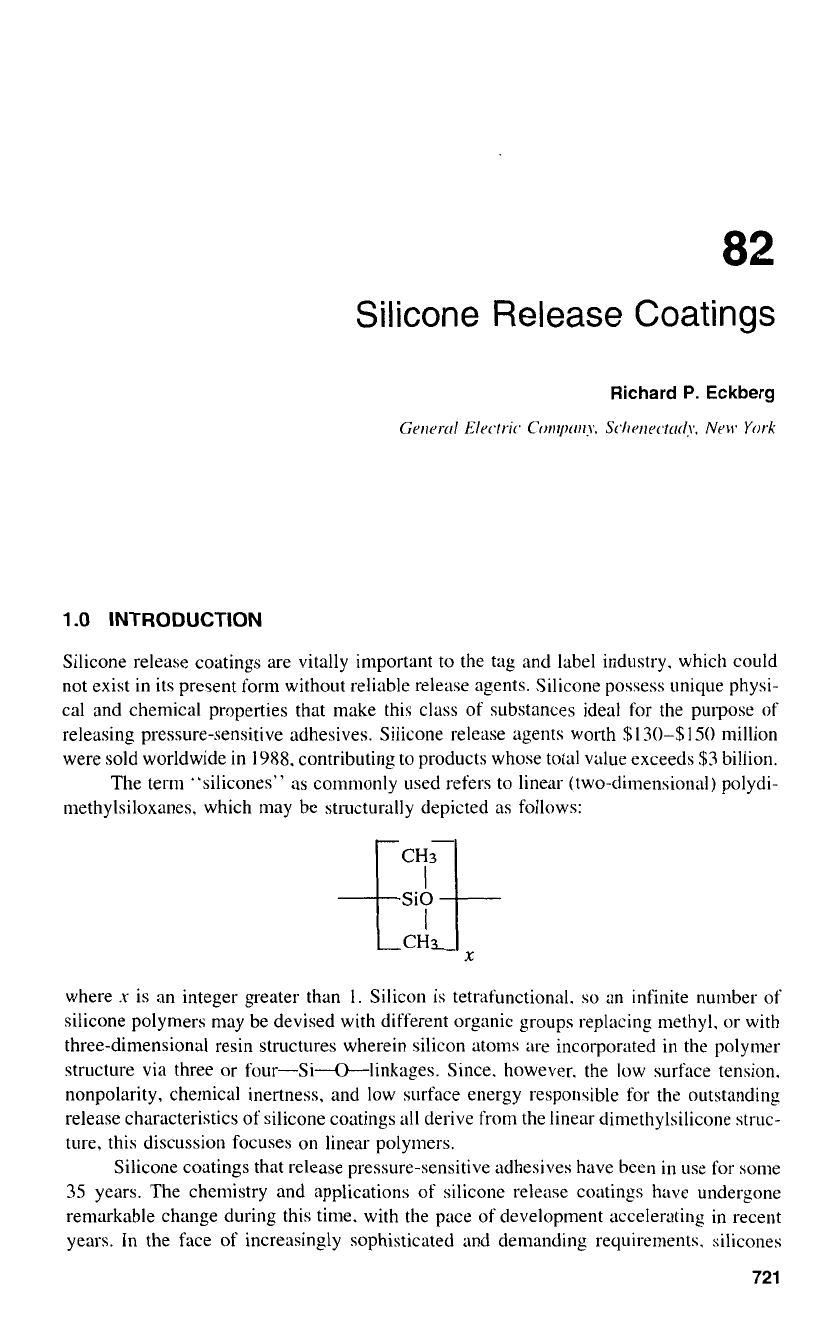
82
Silicone Release Coatings
1
.O
INTRODUCTION
Silicone release coatings are vitally important
to
the tag and label industry, which could
not exist in its present form without reliable release agents. Silicone possess unique physi-
cal and chemical properties that make this class of substances ideal for the purpose of
releasing pressure-sensitive adhesives. Silicone release agents worth
$
I30-$150
million
were sold worldwide in 1988. contributing to products whose total value exceeds
$3
billion.
The term “silicones” as commonly used refers to linear (two-cli~nensional) polydi-
methylsiloxanes, which may be structurally depicted as follows:
where
S
is an integer greater than
1.
Silicon is tetrafunctional.
so
an infinite number of
silicone polymers may be devised with different organic groups replacing methyl. or with
three-dimensional resin structures wherein silicon atoms are incorporated in the polymer
structure via three or four-Si”Q-iinkages. Since. however. the low surface tension,
nonpolarity, chemical inertness, and low surface energy responsible for the outstanding
release characteristics of silicone coatings
all
derive from the linear dimethylsilicone struc-
ture, this discussion focuses
on
linear polymers.
Silicone coatings that release pressure-sensitive adhesives have been
in
use for some
35
years. The chemistry and applications
of
silicone release coatings have undergone
remarkable change during this time. with the pace of development accelerating in recent
years. In the face
of
increasingly sophisticated and demanding requirements. silicones
721
